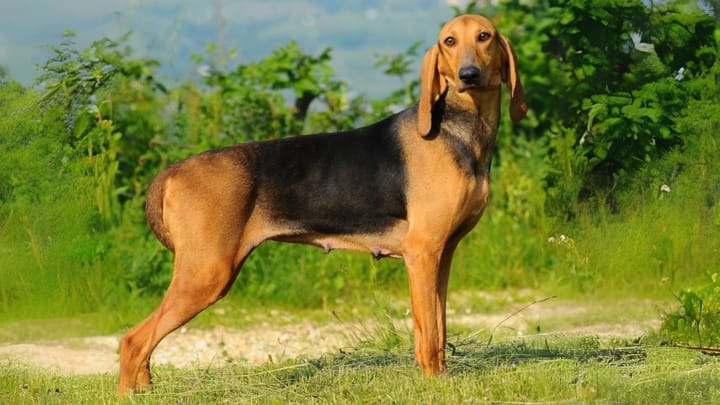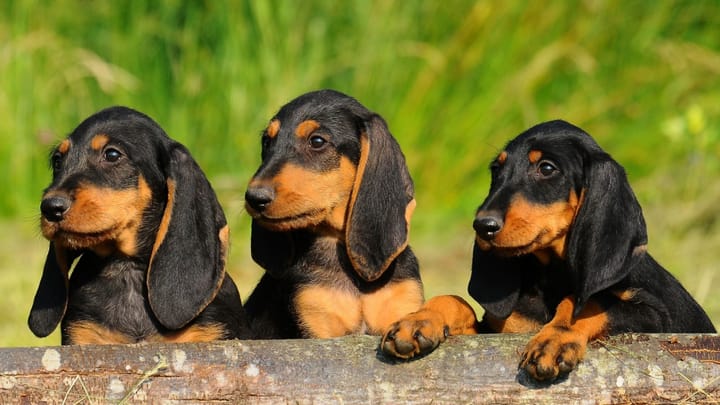Italian Segugio
Other names : Segugio Italiano, SEGIT, Italian Hound


This Italian breed of canine is from the scent hound group. This ancient dog group actually comes in two coat varieties – a wire haired and a smooth haired dog. In addition to being a scent hound, the Segugio Italiano also excels at hunting and the capture and killing of his prey.
|
Life expectancy |
The Italian Segugio has a life expectancy of between 12 and 14 years |
|
Temperament |
|
|
Size |
Medium
|
|
Adult size |
Female
Between 20 and 23 in
Male
Between 20 and 24 in
|
|
Adult weight |
Female
Between 40 and 57 lb
Male
Between 44 and 62 lb
|
|
Coat colour
This dog’s coat appears in a variety of colours - black and tan and any shade from red to fawn. |
Black Red |
|
Type of coat
There are 2 varieties of the Segugio Italiano dog. One has a wiry, harsh coat that is around 5cm in length. The other, a smooth haired dog, has a short, thick, shiny coat. |
Very short Long Hard |
|
Eye colour
Brown or Amber. |
Brown
|
It will be no surprise if you have never even heard of this breed of dog. This is probably because not even one dog has been registered in the United Kingdom during the last 10 years. Any prospective owners will need to look further afield, most likely to Europe, to find a puppy.
More details about the Italian Segugio
Italian Segugio: Origins and history
The Segugio Italiano, or SEGIT as it is also known, is an ancient breed dating back thousands of years. It was initially bred by farmers, who needed a dog to hunt hare and rabbits and in some cases, even wild boar. The breed is more common in Italy, but not well known elsewhere.
Remains of other dogs, very similar to this breed, were found in the province of Verona. Also, a painting from around 1600, in the Borso d’Este castle, displays a dog very similar to the Segugio Italiano. Although no one really knows of their exact ancestry, these artefacts go some way to prove his heritage in Italy. In more recent years, the Segugio has become one of the most popular Italian hunting dogs.
Physical characteristics of the Italian Segugio
The Segugio Italiano is a medium sized dog, athletic but not heavy. His lean, long limbs together with his muscular build allow him to hunt over many terrains for long periods. His square-shaped body is broad, but not stocky. He has a large, long head carried on a slender long neck. The Segugio’s ears are triangle-shaped and are set low on the side of his head.
FCI classification of the Italian Segugio
-
Group 6 - Scent hounds and related breeds
-
Section 1 : Scent hounds
Italian Segugio: Varieties
- Italian Short-haired Segugio
- Italian Rough-haired Segugio
Italian Segugio: Characteristics
Italian Segugio: Behaviour
Training a Italian Segugio
Although these canines are eager to please and train quite easily, a firm but consistent hand is required. He can also be quite stubborn if repetitive routines are used when training. As a noisy dog, his “singing” can annoy the neighbours, so the Segugio Italiano must be taught the command to remain quiet from a very young age.
Italian Segugio: Lifestyle
Breed compatibility Italian Segugio
Italian Segugio: Purchase price
As this dog breed appears to be quite rare outside of its native Italy, it can cost anywhere from £300 upwards. In addition, a monthly budget of around £100 to £120 is needed to meet his dietary needs, vet bills, and pet insurance costs.
Italian Segugio: Grooming
This dog breed has 2 different coat types, smooth and short, and coarse and wiry. However, both types of hair need minimal grooming. Care must be taken with the Segugio Italiano’s long ears, to keep them clean and free from infection.
Italian Segugio: Health
There are no documented health issues with this breed at present. Its average life expectancy is 12 to 14 years.
The Segugio Italiano scent hound is known for his powerful nose and muscular legs. This breed can work over any terrain with speed and accuracy for many hours.
As a working dog, he doesn’t generally suffer any ill effects from hunting in warmer climates.
This dog won’t have any issues being outside in cooler climates.
As is the case with many working dogs, providing they are given adequate exercise, they shouldn’t gain any additional weight. However, for a retired scent hound, there is more of a risk of obesity once he becomes more sedentary, with little exercise.
- Gastric dilatation/volvulus
- Glaucoma
- Heart defects
- Hip dysplasia
- Hypothyroidism
- Progressive Retinal Atrophy






